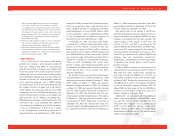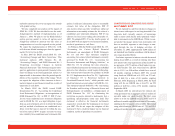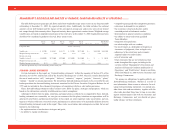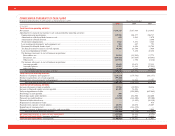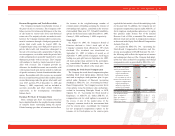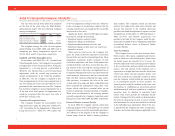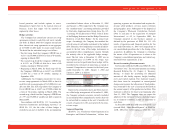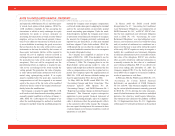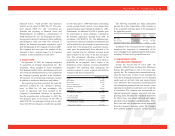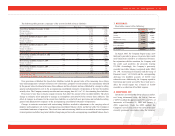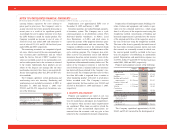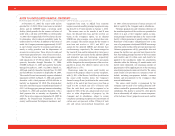Advance Auto Parts 2005 Annual Report Download - page 43
Download and view the complete annual report
Please find page 43 of the 2005 Advance Auto Parts annual report below. You can navigate through the pages in the report by either clicking on the pages listed below, or by using the keyword search tool below to find specific information within the annual report.
Revenue Recognition and Trade Receivables
The Company recognizes merchandise revenue at
the point of sale to customers. The Company estab-
lishes reserves for returns and allowances at the time
of sale based on current sales levels and historical
return rates. The majority of sales are made for cash;
however, the Company extends credit to certain com-
mercial customers through a third-party provider of
private label credit cards. In August 2005, the
Company began using a new third party to process its
private label credit card transactions subsequent to
the sale of its existing credit card portfolio. Under the
new arrangement, receivables under the private label
credit card program are generally transferred to a new
third-party provider with no recourse. The Company
will continue to transfer a limited amount of receiv-
ables with recourse. The Company provides an
allowance for doubtful accounts on receivables sold
with recourse based upon factors related to credit risk
of specific customers, historical trends and other infor-
mation. Receivables sold with recourse are accounted
for as a secured borrowing. Receivables and the related
secured borrowings under the private label credit card
were $587 and $26,898 at December 31, 2005 and
January 1, 2005, respectively, and are included in
accounts receivable and other current liabilities,
respectively, in the accompanying consolidated
balance sheets.
Earnings Per Share of Common Stock
Basic earnings per share of common stock has
been computed based on the weighted-average number
of common shares outstanding during the period.
Diluted earnings per share of common stock reflects
the increase in the weighted-average number of
common shares outstanding assuming the exercise of
outstanding stock options, calculated on the treasury
stock method. There were 517, 510 and 89 antidilutive
options for the fiscal years ended December 31, 2005,
January 1, 2005 and January 3, 2004, respectively.
Stock Split
On August 10, 2005, the Company’s Board of
Directors declared a 3-for-2 stock split of the
Company’s common stock, effected as a 50% stock
dividend. The dividend was distributed on
September 23, 2005 to holders of record as of
September 9, 2005 and the Company’s stock began
trading on a post-split basis on September 26, 2005.
All share and per share amounts in the accompany-
ing consolidated financial statements have been
restated to reflect the effects of the stock split.
Accounting for Stock-Based Compensation
The Company has stock-based compensation plans
including fixed stock option plans, deferred stock
units and an employee stock purchase plan. As per-
mitted under Statement of Financial Accounting
Standard, or SFAS, No. 123, “Accounting for Stock-
Based Compensation,” the Company accounts for its
stock options using the intrinsic value method pre-
scribed in Accounting Principles Board, or APB,
Opinion No. 25, “Accounting for Stock Issued to
Employees,” or APB No. 25. Under APB No. 25,
compensation cost for stock options is measured as
the excess, if any, of the market price of the
Company’s common stock at the measurement date
over the exercise price. Accordingly, the Company
has not recognized compensation expense on the
issuance of its fixed options as the exercise price
equaled the fair market value of the underlying stock
on the grant date. In addition, the Company has not
recognized compensation expense under APB No. 25
for its employee stock purchase plan since it is a plan
that qualifies under Section 423 of the Internal
Revenue Code of 1986, as amended. The issuance of
deferred stock units results in compensation expense
as discussed in the Equity Stock-Based Compensation
footnote (Note 20).
As required by SFAS No. 148, “Accounting for
Stock-Based Compensation–Transition and Dis-
closure an amendment of FASB Statement No. 123,”
the following table reflects the impact on net income
and earnings per share as if the Company had adopt-
ed the fair value method of recognizing stock-based
compensation costs as prescribed by SFAS No. 123.
2005 2004 2003
Net income, as reported ......... $234,725 $187,988 $124,935
Add: Total stock-based
employee compensation
expense included in
reported net income,
net of related tax effects.... 225 304 —
Deduct: Total stock-based
employee compensation
expense determined
under fair value based
method for all awards,
net of related tax effects.... (9,622) (5,977) (4,636)
Pro forma net income ............ $225,328 $182,315 $120,299
Net income per share:
Basic, as reported................... $ 2.17 $ 1.70 $ 1.14
Basic, pro forma .................... 2.08 1.64 1.10
Diluted, as reported................ 2.13 1.66 1.11
Diluted, pro forma.................. 2.04 1.61 1.07
Advance Auto Parts
I
Annual Report 2005
I
41


